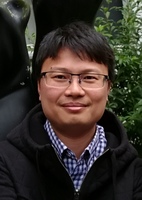 |
Education |
- 2004-2010 Ph.D in Physics, National Taiwan Univeristy, Taiwan.
- 2000-2004 B. S. in Physics, National Central University, Taiwan.
|
 |
Professional Experience |
Current position:
- 2023/08--present Associate Professor of Physics, National Tsing Hua University, Taiwan.
- 2017/08~2023/07-present, Assistant Professor of Physics, National Tsing Hua University, Taiwan.
Experience:
- 2014-2017, Postdoc. of Physics, Hamburg University, Germany
- 2011-2014, Postdoc. of Physics, Würzburg University, Germany
|
 |
Research Fields |
-
- Experimental surface magnetism
- Spintronics
- Non-collinear magnetic spin structures
- Spin-polarized scanning tunneling microscopy
|
 |
Research Interests and achievement |
Updated on August 9, 2017
My research interests are currently focused on investigating frontier magnetic spin textures and novel spin-correlated phenomena down to atomic scale by spin-polarized scanning tunneling microscopy.
The main topics are categorized as following:
- Magnetic skyrmions in low-dimensional systems:
A new class of non-collinear magnetic spin textures, e.g., chiral domain wall, spin spiral and magnetic skyrmions etc., has recently received a significant amount of attention because of their novel properties in the applications of spintronic devices and magnetic information technology. I’m in particular interested in studying the magnetic skyrmions in low-dimensional magnetic materials including Neél skyrmions in ultrathin films, Bloch skyrmions in MnSi and FeGe, antiferromagnetic skyrmions in antiferromagnetic materials, antiskyrmions in Heusler compounds and skyrmions with higher nontrivial topological numbers etc.
2. Tailoring non-collinear magnetic spin structures:
Artificially engineering and manipulating will be an important step toward the realization of prototype devices. I’m also interested in tailoring non-collinear magnetic spin textures by means of atomic lattice rearrangement and hetero-elements incorporation. In atomic monolayers of films, the surface reconstruction can induce the self-assembled structural network, which can create impact on the non-collinear magnetism due to subtle balance of different interaction energy terms. Another approach is to incorporate hetero-elements in the magnetic materials, through not only structural displacement, but also electronically hybridization, we aim for tuning the magnetic behaviors in an unconventional manner.
3. Strong spin-orbit coupled materials:
Dzyaloshinskii-moriya interaction (DMI) plays the crucial role in non-collinear magnetism, which is the consequence of strong spin-orbital coupling with the breaking inversion symmetry. Up to date, topological insulators, Weyl semimetals, and Rashba materials etc., possess exotic states in hybrid band dispersion of low-dimensional systems. I would like to investigate the magnetism as well as corresponding influences on the spin-correlated phenomena among the horizon of these materials.
|
 |
Selected Publications |
- P.-J. Hsu, L. Rózsa, A. Finco, L. Schmidt, K. Palotás, E. Vedmedenko, L. Udvardi, L. Szunyogh, A. Kubetzka, K. von Bergmann, and R. Wiesendanger, "Inducing skyrmions in ultrathin Fe films by hydrogen exposure", Nat. Commun., 9, 1571, (2018)
- A. Finco, R. Levente, P.-J. Hsu, A. Kubetzka, E. Vedmedenko, K. von Bergmann, and R. Wiesendanger, "Temperature-induced increase of spin spiral periods", Phys. Rev. Lett., 119, 037202, (2017)
- P.-J. Hsu, A. Kubetzka, A. Finco, N. Romming, K. von Bergmann, and R. Wiesendanger, "Electric field driven switching of individual magnetic skyrmions", Nat. Nano., 12, 123-126, (2017)
- P.-J. Hsu, J. Kügel, J. Kemmer, F. P. Toldin, T. Mauerer, M. Vogt, F. Assaad, and M. Bode, "Coexistence of charge and ferromagnetic order in fcc Fe", Nat. Comm., 7, 10949, (2016)
- P.-J. Hsu, A. Finco, L. Schmidt, A. Kubetzka, K. von Bergmann, and R. Wiesendanger, "Guiding spin spirals by local uniaxial strain relief", Phys. Rev. Lett., 116, 017201, (2016)
- J. Kügel, M. Karolak, J. Senkpiel, P.-J. Hsu, G. Sangiovanni, and M. Bode, "On the relevance of hybridization and filling of 3d orbitals for the Kondo effect in transition metal phthalocyanines", Nano Lett., 14, 3895, (2014)
- P.-J. Hsu, T. Mauerer, M. Vogt, J. J. Wang, J. S. Oh, S.-W. Cheong, M. Bode, and W. Wu, "Hysteretic melting transition of a soliton lattice in a commensurate charge modulation", Phys. Rev. Lett., 111, 266401, (2013)
|
|

